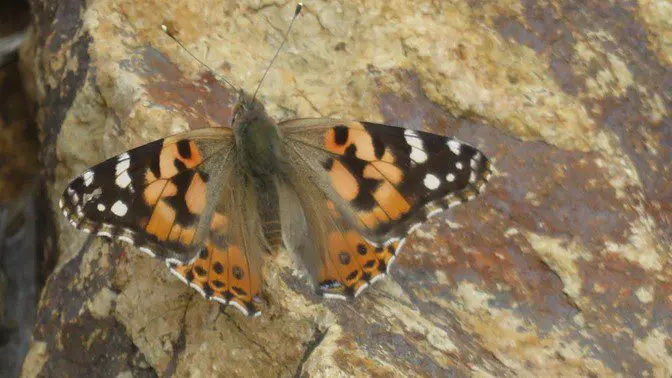The Painted Lady

WHAT WETLANDS PARK BUTTERFLY WINS THE PRIZE FOR BIGGEST HOME RANGE?
During the years I worked at the Clark County Museum, I liked to use part of my lunch break to walk the grounds. This one day in spring was a perfectly warm one, with just the hint of a breeze. Much to my surprise, I ended up walking into a “blizzard” of butterflies!
As I headed through the Outdoor Classroom (toward Boulder Highway), I started seeing butterflies. At first, there were just a few, but as I walked, there were more and more, until the air around me was thick with beautiful black and orange wings. Eventually, there were so many that I just stopped and stared. Some even landed on the front of my shirt, wings fanning gently, and one landed right below my glasses on my nose! Were they Monarchs? No – they had four blue “eyespots” on the underside of their hindwings. It turns out I had walked into a “kaleidoscope” or “flutter” or “swarm” of Painted Lady butterflies! Thousands of them were all flying down toward the Las Vegas Valley parallel to Boulder Highway. Never, before or since, have I seen so many!
Later, I learned that my experience was not unique. Painted Ladies are perhaps the most widely distributed butterflies in the world. They are found in Africa, Europe, Asia, and North and South America – every continent except Antarctica. In every population, the butterflies migrate north in spring, and south in fall, flying about 100 miles a day, sometimes for several thousand miles. The butterfly “storm” streaming past me on that warm spring day was a normal part of the annual spring migration of Painted Ladies northward out of Mexico, heading north to lay their eggs.
Once they arrive on their breeding grounds, male Painted Ladies select perches, often on tall shrubs, and patrol the area around them in search of receptive females. The females lay their pinhead-sized eggs singly on the tops of host plant leaves. Over a hundred plant species serve as host plants providing food and housing for larval Painted Ladies. Favorites include thistles, mallows, knapweeds, sunflowers, and sages.
When the caterpillars hatch, they feed on the leaves of the host plant, sheltering in silk nests they make for protection from a variety of predators. Predators interested in Painted Ladies (both caterpillars and adults) for lunch include hungry birds, bats, reptiles, frogs, ants, wasps, and spiders.
After a Painted Lady emerges from its chrysalis as an adult, it feeds on flower nectar from plants like thistles, asters, cosmos, blazing star, joe-pye weed, red clover, and milkweeds. As they sip nectar, the butterflies serve as pollinators for their food plants. Painted Lady adults also enjoy aphid honeydew, and will gather in groups to feed on mineral-rich mud puddles or damp soil. This behavior is called “puddling,” and provides the butterflies with nutrients needed for them to survive and reproduce. Adults escape their many predators by camouflage and quick, athletic flight.
As you walk the trails at Clark County Wetlands Park in spring, summer, or fall, watch for the resident Painted Ladies in flight, on the ground, or sipping nectar from a convenient flower. Their two-to-two-and-seven-eighths inch wide wings are gorgeously marked in orange, black, and white. Hint: other orange and black butterflies seen in the Park lack the four blue “eyespots” Painted Ladies have near the underside back edge of their hindwings.
– By Chris Leavitt, President; photo courtesy Clark County Wetlands Park
Please enjoy these YouTube videos!
Painted Lady Butterflies MikeBlairOutdoors 2:33
Painted Lady Caterpillar to Butterfly Time Lapse Warren Photographic 0:25
ID: Painted Lady Butterflies – Nature and Wildlife The Coypu Whisperer 1:00
Painted Lady Butterfly (Vanessa Cardui) Beautiful Footage Ally Smith 4:12
